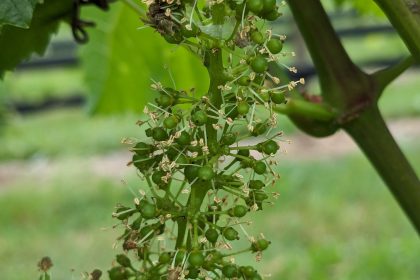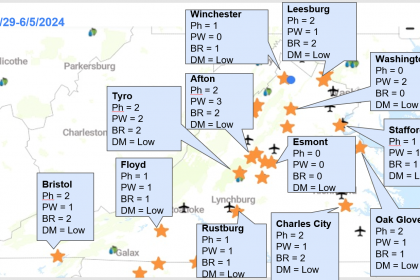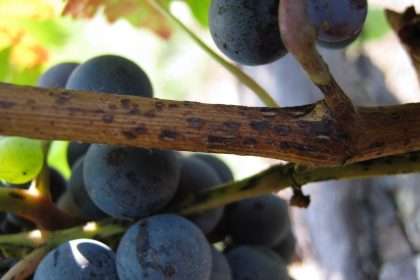The warm May pushed our vines forward rather quickly. Many people in northern VA are about to see blooms (our 3-year old young Chardonnay vines are trace bloom), and I am sure rest of regions are going through bloom by now. This means that many of us are in the critical time for cluster infections by downy mildew, powdery mildew, and black rot. Bloom time is also critical period to prevent Botrytis, ripe rot and Bitter rot, because pathogens of these diseases can infect flower parts and come back later.
We do have materials with kick-back activities against downy (Ridomil products, Phosphonates, etc.) and black rot (myclobutanil, etc.), but infection on flowers and young fruits can happen very fast. Unless we have a very dry season, this is the time where you have to be proactive. (Note: recent warm and humid night time conditions are favoring spore production of downy mildew pathogen) Thus, what I recommend often is use of protectant materials to protect tissues for 4-6 weeks for V. vinifera varieties, and 3-4 weeks for V. labrusca varieties, which should translate into 3-4 sprays for V. vinifera, and 2-3 sprays for V. labrusca. If you have hybirds, they are somewhere in between, so, 4-5 weeks to be protected. As usual, please make sure to rotate mode of action groups.
Here are three examples from our experimental vineyards. (Note: I will add a Phosphonate product for downy mildew whenever we have many rains)
Plan A (my “standard” program)
- At bloom: mancozeb + sulfur + myclobutanil or another DMI + Vangard
- First cover: mancozeb + sulfur + Quintec (or other PM material, such as Vivando or Torino)
- Second cover: mancozeb + sulfur + myclobutanil or another DMI
- Third cover: captan + sulfur + Quintec (or other PM material, such as Vivando or Torino) (Note: if I do not see any evidence of powdery mildew, I may omit Quintec from this spray)
Plan B (if your major concern is downy mildew)
- At bloom: mancozeb + sulfur + Revus Top + Vangard (or another Botrytis material) (Revus Top contains a DMI)
- First cover: mancozeb + sulfur + Quintec (or other PM material, such as Vivando or Torino)
- Second cover: mancozeb + sulfur + Revus Top
- Third cover: captan + sulfur + Quintec (or other PM material, such as Vivando or Torino) (Note: if I do not see any evidence of powdery mildew, I may omit Quintec from this spray)
Plan C (if your major concern is Botrytis)
- At bloom: mancozeb + sulfur + Luna Experience (Luna Experience contains a DMI)
- First cover: mancozeb + sulfur + Quintec (or other PM material, such as Vivando or Torino)
- Second cover: mancozeb + sulfur + myclobutanil or another DMI
- Third cover: captan + sulfur + Quintec (or other PM material, such as Vivando or Torino) (Note: if I do not see any evidence of powdery mildew, I may omit Quintec from this spray)
The spray interval depends on the weather conditions; so, I cannot give you a specific number. However, in general, I would aim for shorter intervals for sprays #1, #2, and #3 (7 to 12 days), but I may relax a bit for #3 and #4 (10 to 14 days), especially if weather conditions do not favor downy or black rot. Please note that I am saving my DMI and Quintec (or Vivando, or any other new powdery material) usages for the critical period, thus this is the only time we spray these materials.
I would like to use a mancozeb product around bloom because it has activities against multiple pathogens including pathogens for black rot and ripe rot. Captan is not as effective as mancozeb when it comes to black rot management. The third cover may become too close to the 66-day PHI, so, you need to be careful with the usage of a mancozeb product.
Of course the examples above are just examples, and there are many other options. For example, there are many materials available for both downy and powdery mildew management in recent years. Please refer to our PMG for more details.





